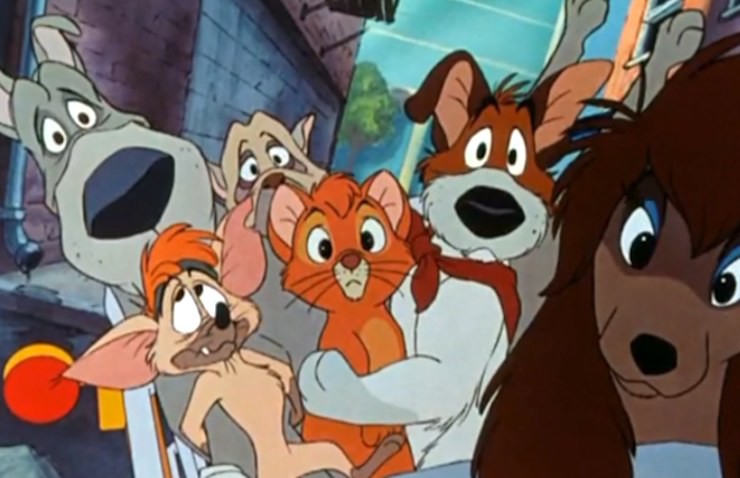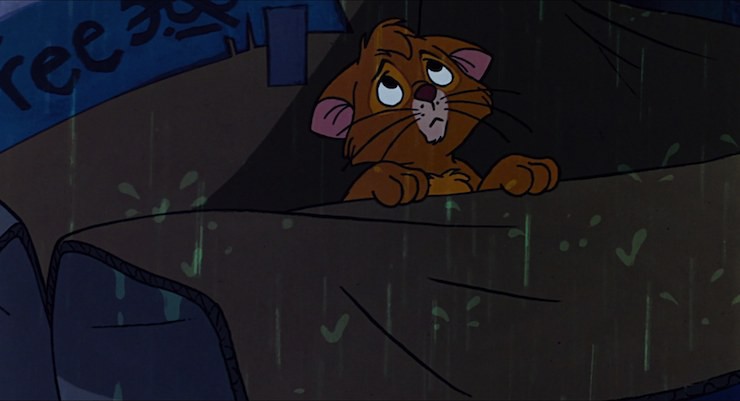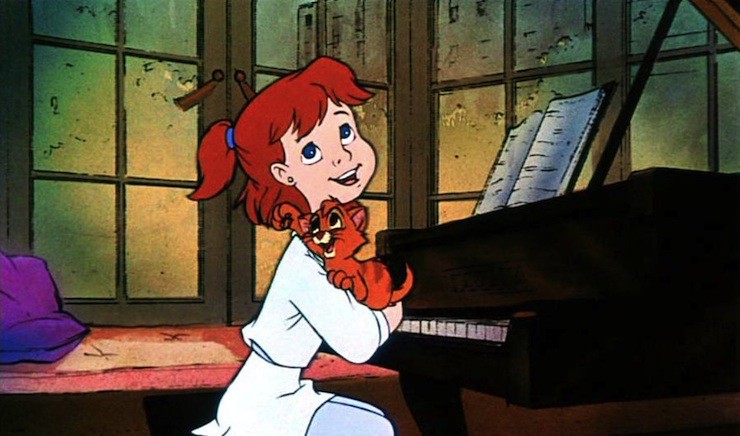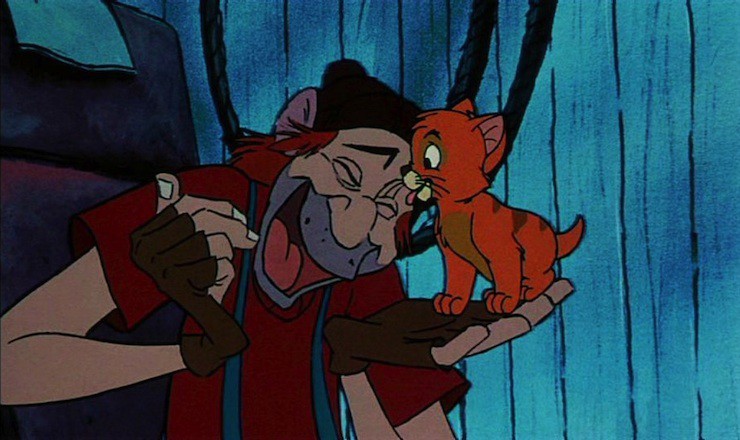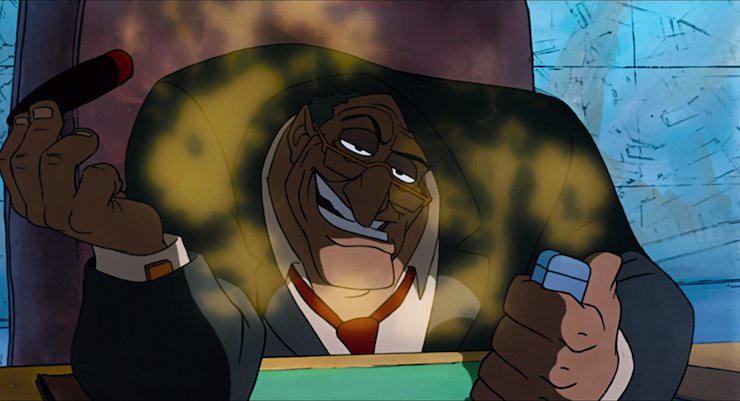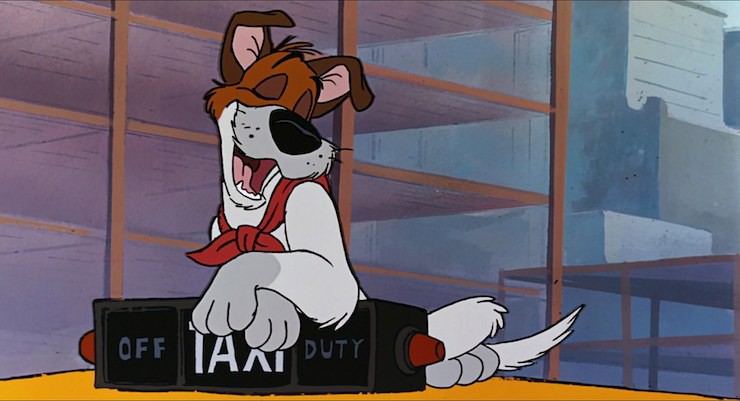As work started on Oliver and Company, the Disney animation studio was, to put it mildly, in a depressed mood. Roy Disney had returned to head the animation department—a plus—but the animation department was still dealing with newly arrived Disney CEO Michael Eisner and newly arrived chairman of Walt Disney Pictures, Jeffrey Katzenberg. The animation department had a particularly tense relationship with Katzenberg, who had not liked The Black Cauldron at all and done something the animators considered unforgivable: personally cut the film. The glory and success of Who Framed Roger Rabbit was still in production and had not yet appeared on screen, and the entire animation department was now glumly working in a warehouse instead of their nice animation studios.
Yet, despite all this, an unsympathetic Jeffrey Katzenberg ordered the animation department to produce one film per year. This was an ambitious order for a department that had barely managed to do this under Walt Disney’s direction, and not at all in the years since his death, and for a department that was understaffed and—despite The Rescuers and The Black Cauldron—not trained to the rigors of the old days.
It was probably the perfect time to focus on adapting Charles Dickens’ mercilessly cheerful work, Oliver Twist.
Oliver Twist had already been adapted into numerous stage productions, films and television miniseries, all more or less unfaithful to the original. Disney stuck to that pattern, so much so that when I saw this film, I almost pulled it from this Read-Watch for the same reason I’ll be skipping The Lion King and Pocahontas; at a certain point, “vaguely connected to the source material” just isn’t enough. But if Oliver and Company isn’t particularly like the Dickens novel (it really isn’t), and isn’t a very good film (it really really isn’t), it is a relatively important film in Disney history, because this is the first full length animated film Peter Schneider worked with.
Disney had hired Schneider to run the animation department in 1985 (with Roy Disney as chairman), shortly after their awareness of The Black Cauldron disaster; he would remain there until 1999. His first triumph involved coordinating production with Amblin Entertainment and Touchstone Pictures through the production of Who Framed Roger Rabbit. His last accomplishment with Disney (depending upon how you look at it) involved negotiating the deal that brought Pixar firmly into the Disney fold. In between, he kept Disney animators on track to fulfill Katzenberg’s one animated feature per year directive. Which is to say, like many people at Disney then and now, I’d ask you not to judge the guy by Oliver and Company. We’ve all made mistakes, and Beauty and the Beast was yet to come.
Meanwhile, we have Oliver and Company.
Sigh.
The film does have a few resemblances to the Dickens novel. It has an adorable orphan kitten eventually called “Oliver” (initially called “you” and “kitten”) and a charming dog thief called “Dodger,” and a gang of dog thieves and a thief named “Fagin” and a mean guy named “Sykes.” Also, both Olivers have to squeeze through some tight spots, go on adventures, and eventually get happy yet very platonic endings with a girl. Also both Olivers occasionally squeak that they are hungry.
And that’s about it. It’s not, frankly, that I was expecting a Disney animated film of all things to tackle the novel’s fierce social satire and examination of the darker aspects of the criminal underworld, and I’m frankly just as glad that the Disney film entirely tossed out the second half of Oliver Twist with all of its suspiciously coincidental plot twists and mysteriously returning half-brothers. But I am somewhat surprised that Disney never tackled the fairy tale aspect of Oliver Twist that I mentioned in the discussion of the novel, and outright surprised that Oliver and Company turned Fagin (Fagin!) into, well, a rather nice guy.
So, what is in Oliver and Company? Well, little Oliver is put in a box with other adorable little kittens only no one adopts him so he gets rained on and then kicked by a hot dog seller (this film doesn’t seem to like New Yorkers very much) and then Dodger comes along and they steal some hot dogs together only Dodger won’t share them so Oliver uses a convenient musical number to chase Dodger to Fagin’s hideout where Fagin turns out to be a kinda nice sort of thief who reads books to his doggies (and now one kitten) only Fagin’s in desperate trouble because he owes Very Mean Guy Sykes some money so the dogs try to rob a limo with Oliver’s enthusiastic help only things go badly in part because of enthusiastic Tito the Chihuahua, and Oliver is sorta kidnapped by a six year old, and just as the story is going nowhere, Bette Midler comes out to sing a song about being a classy poodle, which, ok. A squirrel is briefly involved. The dogs try to rescue Oliver, which would be more interesting if it was necessary, but it isn’t, and thanks to this, the six year old really does get kidnapped, which leads to a chase scene and Sykes’ inevitable and not particularly tragic demise.
I’ve made it sound like a lot is happening, but really, not a lot is, because between all of this, nothing is happening. Oliver and Company has scene after scene where characters do nothing but cuddle kittens (cute as this is), or dance (ditto) or exchange some inane dialogue (not so much.) It gets, well, dull.
Even when something is happening, it’s rather difficult to care. It’s hard to cheer on the dogs when they go in the six year old’s house to rescue the kitten, for instance, because the kitten, at this stage, has never been happier in his little kitten life and indeed is living in the lap of kitten luxury. (The six year old, Jenny, just happens to live on Fifth Avenue in the sort of house that only fabulously, fabulously wealthy New Yorkers can even dream of having.) If this scene were played more as a comedy of errors, it would work, but it isn’t; instead, we see a bunch of dogs tear a happy little kitten away from a little girl, and then see a dog sulk because the kitten isn’t terribly grateful for the favor and—from the dog’s point of view—now thinks he’s too good to hang out with dogs.
It’s also difficult to conjure up much sympathy for Fagin, even when Fagin orders the dogs and the kitten to go out and steal something because otherwise he’ll die and “Dead men do not buy dog food.” This is all very nice and touching, except for the not so small problem that the film just showed us that all of the dog food is coming from Dodger, and all of the rest of the (limited) income is coming from the dogs.
It’s not that Fagin, in this version, is all terrible—he’s fond of the dogs and reads stories to them which makes them happy enough, and the dogs are clearly fond of him, which says something, though genuinely evil guy Sykes also has two dogs who are fond of him, so…maybe it doesn’t say that much. And later, Fagin seems to feel genuinely guilty about trying to use an adorable kitten to get money out of a little girl. To his slight credit, without that money, he’ll die; he not unnaturally assumed that the kitten now belonged to wealthy adults; and he does give the kitten back as soon as he sees just how upset Jenny is. Having said all that, this is the same guy who is asking dogs to risk their lives stealing things—including cars—for him, and who just threatened to kill a kitten if he wasn’t paid up—all in order to cover up one of his mistakes, borrowing money from Sykes.
Sure, the movie wants us to believe that Fagin is really a nice, kindhearted sort of guy who just, well, happens to have his dogs stealing for him, happens to make terrible financial decisions that leave the dog in danger, happens to send ransom notes about adorable little kittens the second he realizes that the kitten has ended up on Fifth Avenue, and just happens to make a series of mistakes that leaves yet another dead person and crashed car in the East River. But I’m having problems believing it. Oh, I’m aware that the East River is now used to getting this sort of treatment from films, so is probably ok with this, and aware that in many ways, Fagin really is just a pathetic figure down on his luck. I don’t know his backstory in the film—we never get it—and it’s very possible that he, too, was originally a victim here. And for a moment—a brief moment—I did feel sorry—well, I felt something—for this pathetic, beaten guy who still took a moment to read a story to his dogs.
And then the film continued.
It’s something I wish the film had done more with, if only because the idea of a kindhearted, or even sympathetic villain was a mostly new one for Disney, which previously had gone for over the top outrageously evil villains—and continued to do so here with Sykes, although since at first Skyes’ major crimes appear to be just trying to get a repayment for a loan and keeping Dobermans as pets, Skyes initially kinda comes off as almost—well, sympathetic is the wrong word, but perhaps not totally in the wrong. That changes once he kidnaps Jenny, but it’s worthwhile to realize that the only reason Jenny is in even a modicum of danger is because of Fagin and his dogs. I’m delighted that they end up doing the right thing by rescuing her in the end, and less delighted by the circumstances that brought her there.
It’s easier, indeed, to feel sympathy for several other near villains in the Disney lineup—the Huntsman in Snow White, the disgraces to the forces of evil in Sleeping Beauty, Horace and Jasper in One Hundred and One Dalmatians, Mr. Snoops in The Rescuers, and a few others yet to come—goons who are clearly terrified of their evil bosses, with good reason, and who in some cases even do manage to resist their evil overlords. Fagan has his good moments, certainly. But not that many of them, and I’m not quite prepared to call him a complex, let alone truly sympathetic villain, yet.
And alas, even the vocal talents of Billy Joel, Bette Midler, and Ruth Pointer could only do so much with the songs—they’re bouncy enough, but completely forgettable—though fans of Lady and the Tramp and One Hundred and One Dalmatians should keep an eye out during the “Why Should I Worry” number.
These flaws, and long stretches of dull moments, did not stop Oliver and Company from making a decent return at the box office—possibly thanks to Billy Joel, whose name featured heavily in the Disney marketing for this film. Huey Lewis, who sang the opening number, was not featured heavily in the Disney marketing for this film. Sometimes you just have to wonder. It also featured increased computer animation, although the major film to experiment with that was still two films to come. Disney went public with its plans to release a new animated film each year, although they warned investors not to expect too much from the next film, which was just this small thing about a mermaid—they had much bigger pictures coming. In the meantime, they expected decent revenue from Oliver and Company—a joint marketing campaign with McDonald’s Happy Meals had done well, and Disney planned to launch a series of plush toys and other merchandise to capitalize on the film.
Yet within a few years, the only revenue trickling in from Oliver and Company came from continued VHS and later DVD sales (and now presumably Amazon.com screening.) The toys based on the characters have been discontinued, although you can still find Disney Oliver and Company trading pins here and there if you search. The film sank into obscurity, overshadowed by its successor.
The Little Mermaid, coming up next. The literary source, I warn you, is more than a bit depressing.
Mari Ness lives in central Florida.











